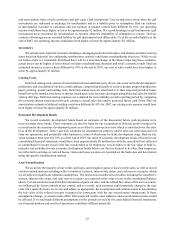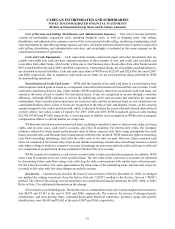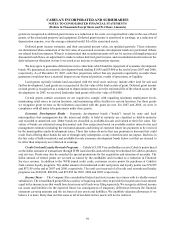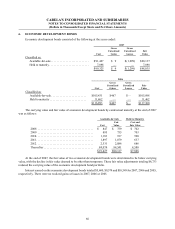Cabela's 2007 Annual Report Download - page 63
Download and view the complete annual report
Please find page 63 of the 2007 Cabela's annual report below. You can navigate through the pages in the report by either clicking on the pages listed below, or by using the keyword search tool below to find specific information within the annual report.
57
CABELA’S INCORPORATED AND SUBSIDIARIES
NOTES TO CONSOLIDATED FINANCIAL STATEMENTS
(Dollars in Thousands Except Share and Per Share Amounts)
Cost of Revenue and Selling, Distribution, and Administrative Expenses – Our cost of revenue primarily
consists of merchandise acquisition costs, including freight-in costs, as well as shipping costs. Our selling,
distribution, and administrative expenses consist of the costs associated with selling, marketing, warehousing, retail
store replenishment, and other operating expense activities. All depreciation and amortization expense is associated
with selling, distribution, and administrative activities, and accordingly, is included in this same category on the
consolidated statement of operations.
Cash and Cash Equivalents – Cash equivalents include commercial paper and other investments that are
readily convertible into cash and have original maturities of three months or less, and credit card and debit card
receivables from other banks, which settle within one to four business days. Receivables from other banks totaled
$9,711 and $10,050 at the end of 2007 and 2006, respectively. Unpresented checks, net of available cash bank balances,
are classified as current liabilities. Cash and cash equivalents of WFB were $123,163 and $52,830 at the end of 2007
and 2006, respectively. Due to regulatory restrictions on our bank, we are restricted from using cash held by WFB
for non-banking operations.
Securitization of Credit Card Loans – WFB sells the majority of its credit card loans to a securitization trust
and recognizes related gains or losses as a component of securitization income in Financial Services revenue. Credit
card loans classified as held for sale, which includes WFB’s transferor’s interest in securitized credit card loans, are
carried at the lower of cost or market. Net unrealized losses, if any, are recognized in income through a valuation
allowance. Although WFB continues to service the underlying credit card accounts and maintains the customer
relationships, these securitization transactions are treated as sales and the securitized loans are not included in our
consolidated balance sheet. Gains or losses are recognized at the time of sale, and depend, in part, on the carrying
amount assigned to the credit card loans sold, which is allocated between the assets sold and retained interest based
on their relative fair values at date of transfer. For 2007, 2006 and 2005, WFB recognized gains on sales totaling
$22,740, $17,410 and $17,020, respectively. A servicing asset or liability is not recognized as WFB receives adequate
compensation relative to current market servicing rates.
WFB retains certain interests in securitized loans, including a transferor’s interest, interest-only strips, servicing
rights, and in some cases, cash reserve accounts, and Class B securities. For interest-only strips, the Company
estimates related fair values based on the present value of future expected cash flows using assumptions for credit
losses, payment rates, and discount rates commensurate with the risks involved. WFB retains the rights to remaining
cash flows (including interchange fees) after the other costs of the trust are paid. However, future expected cash
flows for valuation of the interest-only strips do not include interchange income since interchange income is earned
only when a charge is made to a customer’s account. Interchange income on securitized credit card loans is reflected
as a component of securitization income included in Financial Services revenue.
WFB is required to maintain a cash reserve account under certain securitization programs. In addition, WFB
owns Class B securities from one of the securitizations. The fair value of the cash reserve accounts are estimated
by discounting future cash flows using a rate reflecting the risks commensurate with similar types of instruments.
For the Class B securities, fair value approximates the book value of the underlying loans. Interest-only strips are
recorded at fair value with fair value changes recorded to income.
Inventories – Inventories are stated at the lower of cost or market. Effective December 31, 2006, we changed
our method for valuing inventories from the last-in, first-out (“LIFO”) method to the first-in, first-out (“FIFO”)
method. The effect of this change was not material to our consolidated financial statements for 2007, 2006, or 2005.
Refer to Note 2 for additional information on this change.
All inventories are finished goods. The shrink reserve, estimated based on cycle counts and physical inventories,
was $6,875 and $3,193 at the end of 2007 and 2006, respectively. The reserves for returns of damaged goods,
obsolescence, and slow-moving items, estimated based upon historical experience, inventory aging, and specific
identification, were $6,805 and $5,862 at the end of 2007 and 2006, respectively.
























